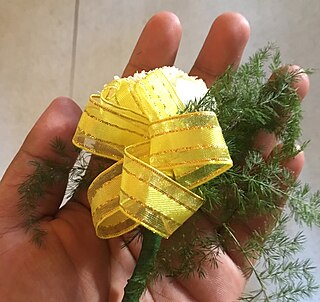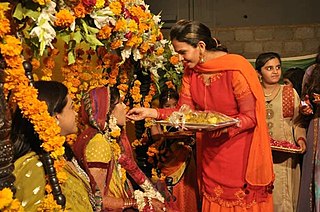
A wedding is a ceremony where two people are united in marriage. Wedding traditions and customs vary greatly between cultures, ethnic groups, religions, countries, and social classes. Most wedding ceremonies involve an exchange of marriage vows by a couple, presentation of a gift, and a public proclamation of marriage by an authority figure or celebrant. Special wedding garments are often worn, and the ceremony is sometimes followed by a wedding reception. Music, poetry, prayers, or readings from religious texts or literature are also commonly incorporated into the ceremony, as well as superstitious customs originating in Ancient Rome.
A white wedding is a traditional formal or semi-formal wedding originating in Great Britain.

A bride is a woman who is about to be married or who is newlywed.
Bridesmaids are members of the bride's party in a Western traditional wedding ceremony. A bridesmaid is typically a young woman and often a close friend or relative. She attends to the bride on the day of a wedding or marriage ceremony. Traditionally, bridesmaids were chosen from unwed young women of marriageable age.

A corsage is a small bouquet of flowers worn on a woman's dress or around her wrist for a formal occasion in the United States. They are typically given to her by her date. Today, corsages are most commonly seen at homecomings, proms, and similar formal events.

A flower bouquet is a collection of flowers in a creative arrangement. Flower bouquets can be arranged for the decor of homes or public buildings, or may be handheld. Handheld bouquets are classified by several different popular shapes and styles, including nosegay, crescent, and cascading bouquets. Flower bouquets are often given for special occasions such as birthdays, anniversaries or funerals. They are also used extensively in weddings. Bouquets arranged in vases or planters for home decor can be arranged in either traditional or modern styles. Symbolism may be attached to the types of flowers used, according to the culture.

The traditional Vietnamese wedding is one of the most important ceremonies in Vietnamese culture, which is influenced by Confucian and Buddhist ideologies.
Iranian wedding, also known as Persian wedding, consists of traditions that go back to the Zoroastrianism, which was the main religion of pre-Islamic Iran and although the concepts theories of marriage have been changed by Islamic traditions, the ceremonies have remained more or less the same as they were originally in pre-Islamic Iran. Although modern-day Iran is a multi-ethnic country, Iranian wedding traditions are observed by the majority of ethnic groups in Iran.

Marriage in Pakistan pertains to wedding traditions established and adhered by Pakistani men and women. Despite their local and regional variations, marriages in Pakistan generally follow Islamic marital jurisprudence. Culturally, marriages are not only seen as a union between a husband and a wife, but also an alliance between their respective families. These traditions extend to other countries around in the world where Overseas Pakistani communities exist.

Punjabi wedding traditions are a strong reflection of Punjabi culture with ritual, song, dance, food, and dress that have evolved over centuries.
A Brunei Malay wedding has many types of ceremonies.

A traditional Russian wedding can last between two days and one week. The celebration involves dancing, singing, toasting, and banqueting. The best man and maid of honor are called Witnesses or Свидетели in Russian. The ceremony and the ring exchange take place on the first day of the wedding. Despite their seemingly unique matrimonial ceremonies, Russian weddings have adopted some western traditions, including incorporating bridesmaids into the wedding party.

Arabic weddings have changed greatly in the past 100 years. Original traditional Arabic weddings are supposed to be very similar to modern-day Bedouin weddings and rural weddings, and they are in some cases unique from one region to another, even within the same country. it must be mentioned that what some people today call "Bedouin" wedding is in fact the original true traditional Arab Islamic wedding without foreign influence.
Afghan weddings are unique and modern celebrations of the people of Afghanistan. It is a tradition in which, like King Amanullah Khan and Queen Soraya Tarzi, the bride and groom whom are respected as King and Queen of the night. This was also the custom in the wedding of Aminullah's cousin to whom he placed down his sword, and kneeled to the ground and told the bride and groom that their wedding night was truly respected, they can make any command as a king and Queen for the night. for the wedding they wear green dresses
Weddings in the United States follow traditions often based on religion, culture, and social norms. Most wedding traditions in the United States were assimilated from other, generally European, countries. Marriages in the U.S. are typically arranged by the participants and ceremonies may either be religious or civil. There is a tradition that the prospective bridegroom ask his future father-in-law for his blessing.

The wedding of Princess Elizabeth, elder daughter of King George VI and heir presumptive to the British throne, and Philip Mountbatten, a former Greek and Danish prince, took place on 20 November 1947 at Westminster Abbey in London. Philip had been made Duke of Edinburgh, Earl of Merioneth and Baron Greenwich on the morning of the wedding.
An Odia Hindu wedding, or bahaghara, is a wedding ceremony performed by Odia Hindu people in the Indian state of Odisha. There are subtle differences in the rites observed by different castes. In Odia marriage rituals the mother of the bridegroom does not take part in the ceremony. The Utkala Brahmins have their weddings only in the daytime, preferably at midday or in the morning, while the other caste weddings are done during the evening or night. There is the custom of sending betel nuts to family friends for inviting them to the marriage. The first invitation is sent to the family deity as a respect to the lord. Marriages in Odisha are mostly fixed and arranged by the parents. Marriages for serving or capturing is not common. In the Odia community widow remarriage is allowed in some lower caste, in this case the younger brother is allowed to marry the deceased brother's wife. The marriage happens in three major rituals, Nirbandha, Bahaghara (wedding) and Chauthi (Chaturthi) (consummation). A marriage is not considered complete or valid until consummation. These rituals are performed either at the Duara or Tola kanias house.

A wedding is a celebratory ceremony where two people are brought together in matrimony. Wedding traditions and customs differ across cultures, countries, religions, and societies in terms of how a marriage is celebrated, but are strongly symbolic, and often have roots in superstitions for what makes a lucky or unlucky marriage. Superstition is often linked to practices involving luck, fate or prophecy, and while many weddings are now more focused on celebratory traditions, many are still practiced, and numerous well-known wedding traditions have roots in superstitions from previous ages. A common example of a superstition involves no one seeing the bride in her wedding dress until the ceremony.
Weddings in Myanmar, considered auspicious occasions in Burmese culture, reflect various ethnic, religious, and regional traditions. Depending on personal preferences and economic status, Burmese weddings can be religious or secular, and extravagant or simple.













